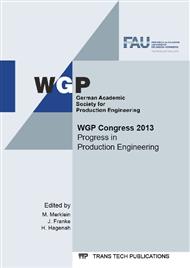[1]
Roland Berger, Lithium-ion batteries - The bubble bursts, Stuttgart, 2012.
Google Scholar
[2]
P. Denholm, E. Ela, B. Kirby, M. Milligan, The Role of Energy Storage with Renewable Electricity Generation, Golden (Colorado) USA, 2010.
DOI: 10.2172/972169
Google Scholar
[3]
J. Kurfer, M. Westermeier, C. Tammer, G. Reinhart, Production of large-area lithium-ion cells - Preconditioning, cell stacking and quality assurance, CIRP Annals - Manufacturing Technology 61 (2012) 1–4.
DOI: 10.1016/j.cirp.2012.03.101
Google Scholar
[4]
A. Väyrynen, J. Salminen, Lithium ion battery production, J. Chem. Thermodynamics (2012) 80–85.
Google Scholar
[5]
DIN, Electrically propelled road vehicles - Battery systems - Dimensions for Lithium-Ion-Cells (91252), Beuth, Berlin, 2011.
Google Scholar
[6]
A. Kampker, P. Burggraef, C. Deutskens, Process alternatives in the battery production, in: Electrical systems for aircraft, railway and ship propulsion (ESARS), 2012, p.1–6.
DOI: 10.1109/esars.2012.6387501
Google Scholar
[7]
J. Fleischer, E. Rupprecht, M. Baumeister, S. Haag, Automated handling of limp foils in lithium-ion-cell manufacturing, in: D.A. Dornfeld, B.S. Linke (Eds.), Leveraging technology for a sustainable world: Proceedings of the 19th CIRP Conference on Life Cycle Engineering, University of California at Berkeley, Berkeley, USA, May 23-25, 2012, Springer, Heidelberg, New York, 2012, p.353–356.
DOI: 10.1007/978-3-642-29069-5
Google Scholar
[8]
VDI, Systematic approach to the development and design of technical systems and products (2221), Beuth, Berlin, 1993.
Google Scholar
[9]
REFA, Methodenlehre der Betriebsorganisation, Planung und Gestaltung komplexer Produktionssysteme, 2nd ed., Hanser, München, 1990.
Google Scholar
[10]
H.-J. Bullinger, Systematische Montageplanung: Handbuch für d. Praxis, Hanser, München, Wien, 1986.
Google Scholar
[11]
B. Lotter, Manufacturing assembly handbook, Butterworths, London, Boston, 1989.
Google Scholar
[12]
S.Y. Nof, W.E. Wilhelm, H.J. Warnecke, Industrial assembly, 1st ed., Chapman & Hall, London, New York, 1997.
Google Scholar
[13]
G. Boothroyd, P. Dewhurst, W.A. Knight, Product design for manufacture and assembly, 3rd ed., CRC Press, Boca Raton, op. 2011.
Google Scholar
[14]
S. Li, H. Wang, S.J. Hu, Y.-T. Lin, J.A. Abell, Automatic generation of assembly system configuration with equipment selection for automotive battery manufacturing, Journal of manufacturing systems 30 (2011) 188–195.
DOI: 10.1016/j.jmsy.2011.07.009
Google Scholar
[15]
A. Kampker, B. Franzkoch, C. Nowacki, Networked product and production development for lithium-ion batteries, Enabling manufacturing competitiveness and economic sustainability (2012) 215–220.
DOI: 10.1007/978-3-642-23860-4_35
Google Scholar
[16]
G. Seliger, F. Szimmat, J. Niemeier, J. Stephan, Automated handling of non-rigid parts, CIRP Annals - Manufacturing Technology 52 (2003) 21–24.
DOI: 10.1016/s0007-8506(07)60521-6
Google Scholar


